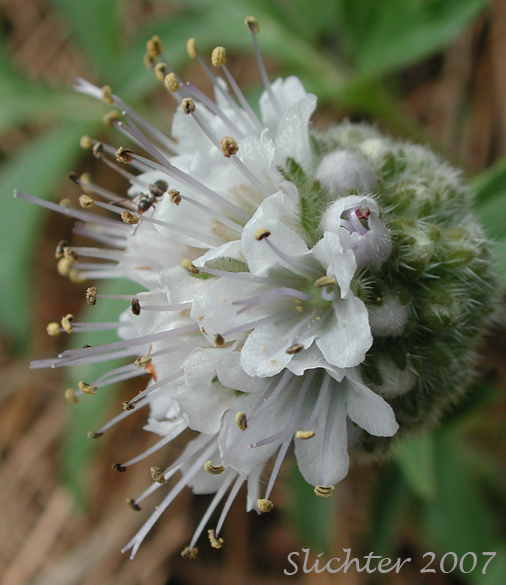 The
photo at right shows a close-up of the capitate inflorescence of ballhead waterleaf (var. thompsonii) as seen along the Willard Springs Trail in the Conboy Lake National Wildlife Refuge..........April 13, 2007. Note that the stigma with its split style as well as the black-tipped
stamens extend well beyond the corolla. Note also how hairy the calyx of each
flower is.
The
photo at right shows a close-up of the capitate inflorescence of ballhead waterleaf (var. thompsonii) as seen along the Willard Springs Trail in the Conboy Lake National Wildlife Refuge..........April 13, 2007. Note that the stigma with its split style as well as the black-tipped
stamens extend well beyond the corolla. Note also how hairy the calyx of each
flower is.
Ball-head waterleaf as seen in the Columbia River Gorge is an upright wildflower from 10-40 cm high which with one to sevral stems arising from a deep but short rhizome with fleshy, fibrous roots. The leaves are few, large, and long petioled, some of whicharise from the stem below the ground. The leaf blade is pinnatifid into 7-11 sessile leaflets or lobes with the blade up to 10 cm wide and 15 cm long. The leaflets range from pointed to more frequently rounded or obtuse.
The inflorescence of variety thompsonii extends well above the leaves (the inflorescence of the other species are typically found below the upper leaves). It is ball-like with numerous white, lavender, or purplish blue flowers from 5-9 mm long. The stamens extend well past the throat of the corolla.
var. thompsonii: The inflorescence is well above the leaves on a flower stem from 5-20 cm long. Found from southern Yakima County, Washington to the Columbia River Gorge where it may be found on both sides of the Columbia River.
var. capitatum: The inflorescence is below the leaves with the stem of the inflorescence less than 5cm long. Found from southern British Columbia south along the eastern slopes of the Cascades of Washington to northeastern Oregon, and east to southwestern Alberta, Utah, and Colorado.
var. alpinum: The inflorescence is found just above ground level, with the stem being almost entirely below ground. Found east of the Cascades from northern Oregon (excluding northeastern Oregon) south to California, Nevada, southwestern Idaho, and western Utah.
Ball-head waterleaf may be found on open to lightly wooded slopes at all elevations from the valleys and foothills to well up in the mountains.
Ball-head waterleaf may be found from southern British Columbia south along the eastern edge of the Cascade Mts. to central Californa and east to Alberta and Colorado.